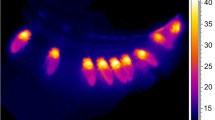Abstract
We have developed a model of foraging behaviour of a honeybee colony based on reaction-diffusion equations and have studied how mapping the information about the explored environment to the hive determines this behaviour. The model utilizes two dominant components of colony's foraging behaviour — the recruitment to the located nectar sources and the abandonment of them. The recruitment is based upon positive feedback, i.e autocatalytic replication of information about the located source. If every potential forager in the hive, the onlooker, acquires information about all located sources, a common information niche is formed, which leads to the rapid selection of the most profitable nectar source. If the onlookers acquire information about some parts of the environment and slowly learn about the other parts, different information niches where individuals are associated mainly with a particular food source are formed, and the correspondent foraging trails coexist for longer periods. When selected nectar source becomes depleted, the foragers switch over to another, more profitable source. The faster the onlookers learn about the entire environment, the faster that switching occurs.
Similar content being viewed by others
Bibliography
M. R. Belic, V. Skarka, J.-L. Deneubourg, and M. Lax, Mathematical-model of honeycomb construction, Math. Biol. 24, 437 (1986).
S. Goss, S. Aron, J.-L. Deneubourg, and J. M. Pasteels, Self-organized shortcuts in the argentine an, Naturwissenschaften 76, 579 (1989).
S. Cazamine and J. Sneyd, A model of collective nectar source selection by honey-bees — Self-organization through simple rules, J. Theor. Biol. 149, 547 (1991).
B. J. Cole, Short-term activity cycles in ants — Generation of periodicity by worker interaction, Am. Nat. 137, 244 (1991).
S. Camazine, J. Sneyd, M. J. Jenkins, and J. D. Murray, A mathematical-model of self-organized pattern-formation on the combs of honeybee colonies, J. Theor. Biol. 147, 553 (1990).
E. Bonabeau, G. Theraulaz, and J.-L. Deneubourg, Fixed response thresholds and the regulation of division of labor in insect societies, Bull. Math. Biol. 60, 753 (1998).
T. D. Seeley, The Wisdom of the Hive, Harvard University Press, Cambridge, 1995.
V. Tereshko, Reaction-diffusion model of a honeybee colony's foraging behaviour, in: Parallel Problem Solving from Nature VI, M. Schoenauer, K. Deb, G. Rudolph, X. Yao, E. Lutton, J. J. Merelo, H.-P. Schwefel, eds., Lecture Notes in Computer Science 1917, Springer, Berlin, 2000, p. 807.
V. Tereshko, Selection and coexistence by reaction-diffusion dynamics in fitness landscapes, Phys. Lett. A 260, 522 (1999).
T. D. Seeley and W. F. Towne, Tactics of dance choice in honey-bes — Do foragers compare dances, Behav. Ecol. Sociobiol. 30, 59 (1992).
P. K. Visscher and S. Camazine, Collective decisions and cognition in bees, Nature 397, 400 (1999).
T. D. Seeley and S. C. Burhman, Group decision making in swarms of honey bees, Behav. Ecol. Sociobiol. 45, 19 (1999).
S. Camazine, P. K. Visscher, J. Finley, R. S. Vetter, House-hunting by honey bee swarms: collective decisions and individual behaviors, Insectes Sociaux 46, 348 (1999).
S. A. Kauffman, The origins of order: self-organization and selection in evolution, Oxford University Press, New York, 1993.
A.S. Mikhailov, Foundations of Synergetics I, Springer, Berlin, 1990.
J.-L. Deneubourg, S. Goss, R. Beckers, and G. Sandini, Collectively Self-Solving Problems, in: Self-Organization, Emergent Properties, and Learning, A. Babloyantz, ed., Plenum Press, New York, 1991, p. 267
J.-L. Deneubourg and S. Goss, Collective patterns and decision-making, Ethol. Ecol. and Evol. 1, 295 (1989).
Author information
Authors and Affiliations
Rights and permissions
About this article
Cite this article
Tereshko, V., Lee, T. How Information-Mapping Patterns Determine Foraging Behaviour of a Honey Bee Colony. Open Systems & Information Dynamics 9, 181–193 (2002). https://doi.org/10.1023/A:1015652810815
Issue Date:
DOI: https://doi.org/10.1023/A:1015652810815




